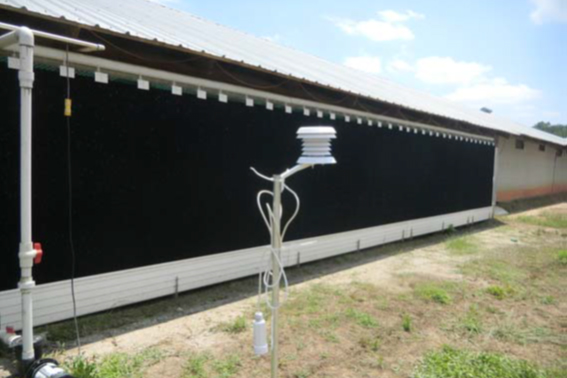Measuring outside air temperature

Having an accurate outside temperature sensor wired into a house’s environmental controller can be helpful in managing the environment within a poultry house.
During cold weather some controllers are able to adjust minimum ventilation rates based on outside temperature. This can be helpful because as outside temperatures decrease, the air tends to contain less moisture so minimum ventilation rates can be slightly decreased, resulting in reduced fuel usage. Side wall inlet static pressure settings can also be tweaked based on outside temperature. The colder it is outside, the heavier the air will be, which means it is best to slightly increase air inlet static pressure settings as outside temperatures drop. A higher level of static pressure increases the speed at which the air enters the house, which will tend to keep the colder air moving along the ceiling longer, increasing the likelihood the air will warm and dry before moving down to floor level.
Evaporative cooling
During the summertime, knowing outside temperature can be very helpful in determining both the amount of cooling produced by an evaporative cooling pad system as whether evaporative cooling pad systems are operating too early in the morning or too late at night. Though evaporative cooling pads should always be operated based on inside temperature, knowing when the outside temperature increases above 80oF (26oC) is a good indicator that the outside humidity has dropped below 80% and it is possible to start considering using an evaporative cooling system to decrease the temperature of the incoming air. If the outside temperature is 80oF (26oC) lower it is generally best not to use evaporative cooling regardless of inside temperature because using it will tend to bring the humidity of the air inside a house above 90% which will not prove beneficial to the birds or the litter. If the house temperature is in the mid to high 80’s when outside temperature is 80oF (26oC) or lower, air is not being exchanged fast enough and more fans should be turned on, not evaporative cooling pads.
Not accurate
The much too common problem on many farms is that the outside temperature sensors that producers are using to make potentially important management decisions are not accurate. The two most common causes of inaccurate outside temperature readings is that outside temperature sensors are commonly mounted on the house itself or at most a few feet from the house and the sensor is exposed to direct or indirect sunlight. In order to obtain an accurate outside temperature reading an outside sensor should be placed at least 15 feet from a poultry house. One of the most common locations for an outside temperature sensor is just outside the control room under the roof eave. The problem with this location is the sun will heat the roof and side walls of the house, which will tend to heat the air in the immediate vicinity making it appear that it is hotter outside than it really is. This will tend to happen not only in the summer but the winter as well. But if an outside temperature sensor is not placed under the eave, the likelihood of direct sunlight striking the sensor increases. When direct sunlight strikes a sensor it will tend to heat the sensor to between 5 and 40 degrees above the ambient air temperature, resulting leading a producer to believe the outside air temperature is much higher than it really is.
Radiation shield
The best way to obtain an accurate outside temperature measurement is to use a solar radiation shield and place the sensor at least 15′ from the poultry house. A solar radiation shield is designed to protect a temperature sensor from direct sunlight while at the same time promoting good air flow over the sensor. The typical solar radiation shield consists of a series of stacked reflective plates with space in the centre for the temperature sensor and a mounting bracket so it can be attached to a pole or post. Solar radiation shields cost between $40 and $80 and are available from poultry house controller manufacturers as well as companies that sell weather stations.
Figure 1 compares an outside temperature sensor placed in a solar radiation shield located approximately 20 feet from a poultry house, with a sensor located next to a feed bin (unprotected from direct sunlight) to a third located under the eave of the house. The temperature sensor exposed to direct sunlight indicated an outside temperature of up to 10 degrees higher than that measured by the sensor in the solar radiation shield enclosure. The sensor that was located under the eave of the house, which was not exposed to direct sunlight, was at times nearly 5 degrees higher than that measured by the shielded sensor.
An outside temperature sensor with a solar radiation shield is a good investment. An outside sensor with a solar radiation shield will help ensure that fans and evaporative cooling systems are activated at appropriate times which will help to maintain litter quality as well as bird performance.
Source: www.poultryventilation.com













